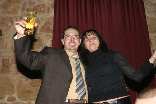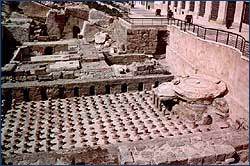| Random image |
 |

Bank Pub and Night Club
|
 |
|
 |
 |
BEIRUT
 Beirut stands on the site of a very ancient settlement going back at least 5,000 years. Its name appeared in cuneiform inscriptions as early as 1,400 B.C, when it was a Canaanite/Phoenician city. In the first century B.C. Berytus, as it was then called, came under Roman rule and was the seat of the famous law school which continued into the Byzantine era. Beirut stands on the site of a very ancient settlement going back at least 5,000 years. Its name appeared in cuneiform inscriptions as early as 1,400 B.C, when it was a Canaanite/Phoenician city. In the first century B.C. Berytus, as it was then called, came under Roman rule and was the seat of the famous law school which continued into the Byzantine era.
In the 6th century A.D. Arab Muslim forces took the city and in 1,110 it fell to the Crusaders. Beirut remained in Crusaders' hands until 1291 when it was conquered by the Mamlukes. Ottoman rule began in 1,516, continuing for 400 years until the defeat of the Turks in World War 1. After the French Mandate Period that followed Lebanon gained its independence in 1943.
Beneath the downtown lie remains of Ottoman, Mamluke, Crusader, Abbassid, Omayyad, Byzantine, Roman, Persian, Phoenician and Canaanite Beirut. Most of these remains were uncovered during the reconstruction of this area in the 1990s.
Beirut has been devastated by several earthquakes throughout its history with each new civilization rebuilding over the old. During the reconstruction of downtown Beirut an enormous number of excavations have heralded pieces from over 17 different civilizations.
Named Beroth, the city of wells, by the Phoenicians. It is one of the oldest settlements of man as evidenced by relics from the prehistoric communities. In Phoenician times, however, it was dwarfed by thriving Byblos, Sidon and Tyre. When occupied by the Romans under the command of Pompey in 64 B.C., it entered the most glorious period of its ancient history. In 15 B.C. it was named Colonia Julia Augusta Felix Berythus and acquired the rights of a Roman city-state. What most contributed to its fame, however, was its School of Law which, under Septimus Severus (192 - 211 A.D.) excelled the Schools of Constantinople and Athens and rivalled that of Rome.
 Beirut retains to this day its role as a great cultural center with great impact on the Middle Eastern region. Its 8 universities have graduated a large number of the area's prime movers and shakers. Its newspapers and publications are read by thousands throughout the Middle East, and it remains the publishing center for the whole area. Beirut retains to this day its role as a great cultural center with great impact on the Middle Eastern region. Its 8 universities have graduated a large number of the area's prime movers and shakers. Its newspapers and publications are read by thousands throughout the Middle East, and it remains the publishing center for the whole area.
It is a commercial, banking and financial center for the region as a whole, with about 85 Lebanese and foreign banks, countless import-export companies, arbitrage and triangular trade operations and free exchange market.
The capital still has many touristic attractions to offer, among them the Beirut National Museum, Raouche with its lively seaside promenade, the Pigeons' Rock, Martyr's Square, Place de l'Etoile, and many shopping centers and a large number of restaurants with succulent menus from cuisines of the world as well as local Lebanese specialties.
Place de L'Etoile
The Clock Tower is based on European urban models, and was designed during the French Mandate period by a French urban planner to replace parts of the old city. Today it faces the Lebanese parliament and it is in the centre of the pedestrian part of downtown encircling cafes, restaurants, and shops.
Raouche (Pigeon Rock)
Raouche area is known for its beautiful Pigeon Rocks, its Corniche (sidewalks) and good Lebanese restaurants. The Corniche is crowded in the evenings and weekends, by strollers, rollerbladers and joggers.
Maarad Street
This street in downtown Beirut is remarkable for its arcaded pedestrian sidewalk and many coffee shops and restaurants. It used to be the site of the Beirut flea market.
Martyr's Square or "Burj"
In 1916 the square was given the name of Martyr's Square in memory of Syrian-Lebanese nationalists who were executed by the Ottomans. In 1925, a new square was planned here in the French style. The square acquired its modern landmark in the 1950's when a monument to the martyrs was erected. This statue was damaged during the war, but it is being repaired. The square today hosts Virgin Megastore, and Nike Sports Town.
Riad el-Solh Square
The square is named after Riad al-Solh, Lebanon's prime minister after independence. Strategically located, it was crossed by everyone who wanted to enter the old town through Bab Yacoub, one of the old city's gates. Today it is off Banks' street, where all major banks are located, and adjacent to numerous downtown restaurants.
The Grand Serail
In 1853, during the Ottoman reign of Sultan Abdul Mejid, the Turks built huge barracks on the highest hill in the town centre. After World War 1, the French occupied the hill, and the racks became the Grand Serail of the French Mandate High Commissioner. Today the building serves as the Council of Ministers headquarters.
The Grand Theatre
Built in the early 1930's by the architect Youssef Aftimous, this building is distinguished by its neo-Islamic style and its capitals, each of which has a different kind of fruit carved upon it. The theatre used to host operas and plays. Today it hosts rave parties, but plans for restoring it as an opera house are underway. It is adjacent to Virgin Megastore.
The Municipality Building
Constructed in the 1920's by the architect Youssef Aftimous, who won a competition for its design, the Municipality Building is in the neo-Islamic style. The building is slated for renovation under the reconstruction program.
Institut Francais d'Archeologie du Proche Orient (I.F.A.P.O)
This building was erected in 1850 by Hajj Abdallah Beyhum. In 1911 the French government bought it and converted it into a home for the elderly. The French Institute of Archaeology was established there in 1946.
Examples of the Roman and Byzantine archeological remains found in downtown Beirut:
 Five columns were found in 1963 on the left of the St. George Maronite Cathedral, that were once part of a grand colonnade of Roman Berytus. Five columns were found in 1963 on the left of the St. George Maronite Cathedral, that were once part of a grand colonnade of Roman Berytus.
A Semi-Circular Cultural Building was discovered west of the St. George Maronite Cathedral, which was moved in 1963 to Boulevard Charles Helou near the eastern entrance to the modern port.
Behind Banks Street in downtown are the remains of the Roman Bath which once served the city's population. Originally discovered in 1968, it underwent a thorough cleaning and further excavation in 1995 - 1997. Now many restaurants overlook the ruins with a fantastic view.
Four Corniced Columns were disovered in 1968 in front of the Parliament Building in Place de L'Etoile.
Five Column Colonnade part of the Roman Basilica were found in the 1940's between Place de L'Etoile and the Great Mosque, and were later erected at the entrance of the National Museum.
Floor Mosaics came from a Byzantine church of the 5th century A.D. , and were moved from Khalde south of Beirut to a site near the National Museum in the 1950's.
Examples of Crusaders, Mamluke, and Ottoman archeological remains found in downtown Beirut:
An excavated Medieval Wall dating from Crusader and Mamluke times was found north of Weygand Street.
A large Crusader Castle once stood near the present port area. Excavations in 1995 revealed a large well-preserved section of the foundation wall complete with Roman column drums used as bond-stones or reinforcements.
Constructed in 1853, as an ottoman military barracks, the Grand Serail was the headquarters of the French governor during the French Mandate. After Lebanon's Independence, it became the Governmental Palace.
Located near the Grand Serail, an Ottoman Clock Tower was built in 1897 and restored in 1994.
Just in front of the Grand Serail, an Ottoman Military Hospital was constructed in 1860. From the French Mandate Period until the 1960's it served as Law Courts. Completely renovated, it now houses the Council for Development and Reconstruction.
Originally the Crusader Cathedral of St. John (1113 - 1115 A.D.), the building was transformed into the Al Omari Mosque by the Mamlukes in 1291.
The Amir Munzer Mosque, also called Nafura, was built in 1620 with eight Roman columns in its courtyard.
Until the recent war in Lebanon The Greek-Orthodox Cathedral of Saint George built in 1767, was the oldest functioning church in Beirut.
|